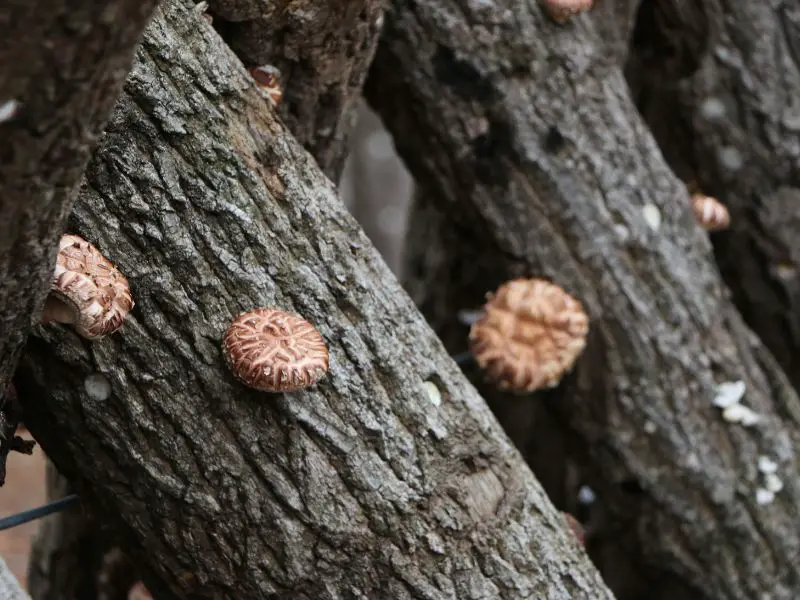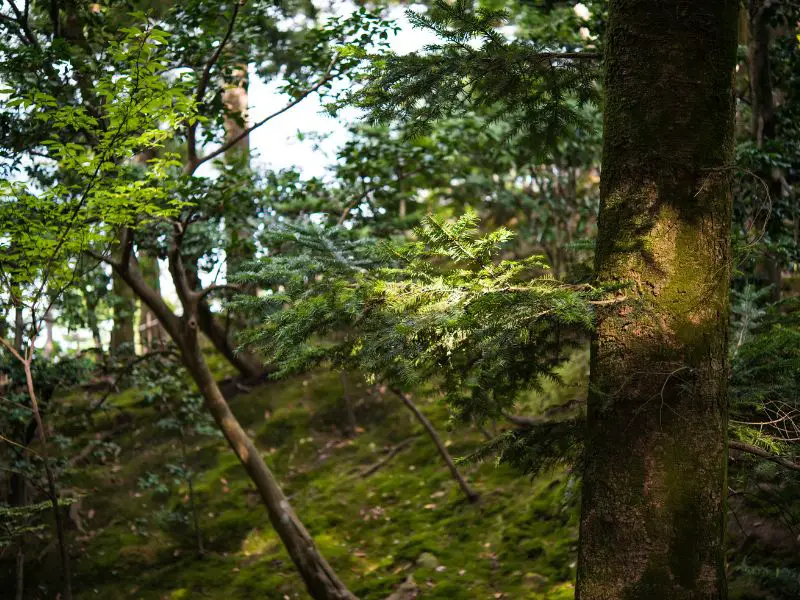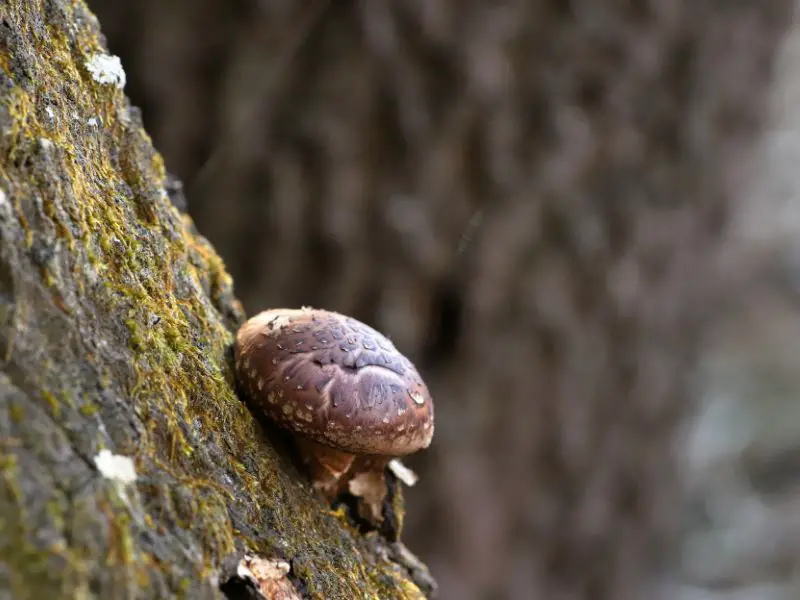I buy shiitake mushrooms the most out of any other mushroom. So, I recently had the idea to grow my own shiitake mushrooms in my backyard. The only problem is, there’s not much information out there on how to do so. So, I did some research and came up with this guide to growing shiitake mushrooms outdoors. Here’s what I found.
Shiitake mushrooms grow outdoors in climates between 45-75°F and 70-80% humidity, usually in temperate deciduous forests. You can mimic this by placing spawn inserts into drilled holes into hardwood logs such as oak or beech, sealing them in the holes with beeswax, and stacking the logs waiting for mushrooms to fruit.

Now let’s see if your climate is suitable and exactly how to grow them.
Preferred Climate For Shiitake Mushrooms
Understanding the preferred climate for shiitake mushrooms is essential to successfully cultivating them in your backyard. Shiitake mushrooms grow in temperate deciduous forests. They have developed a preference for specific temperature and humidity conditions that support their growth.
Temperature
Shiitake mushrooms thrive in temperatures ranging from 45 to 75°F (7 to 24°C). Within this range, they can grow and produce fruiting bodies.
However, they are most productive when temperatures are between 55 and 65°F (13 to 18°C), which is the optimal temperature for mycelial growth and fruiting.
It’s important to keep in mind that exposure to extreme temperatures, either too hot or too cold, can damage the mycelium and stop the production of mushrooms.
Humidity
High humidity levels are crucial for shiitake mushroom growth. These mushrooms prefer a relative humidity of 70-80%.
Maintaining proper humidity encourages the development of fruiting bodies and prevents the mushrooms from drying out.
In a backyard setting, you can maintain humidity by choosing a shaded, well-ventilated location, such as under trees or bushes. Additionally, you can water the logs during dry periods or cover them with a tarp to help conserve moisture.
By creating an environment that mimics the preferred climate for shiitake mushrooms, you increase the chances of a successful and bountiful harvest. If you don’t live in this type of climate, you can mimic temperature and humidity levels indoors.
8 Steps To Grow Shiitake Mushrooms Outside

While they can be grown in the ground, shiitake mushrooms naturally grow on fallen logs or trees, making the log method the most effective way to cultivate them in your backyard.
To make the process of growing shiitake mushrooms more accessible, I’ll break it down into simple steps. Remember, our goal is to mimic nature.
1. Gather Materials
You’ll need hardwood logs (preferably oak, beech, or chestnut), organic shiitake mushroom spawn, a drill with a suitable bit, wax (such as organic beeswax or cheese wax), a brush to apply wax and a mallet.
2. Prepare The Logs
Source logs from trees that have been recently cut, ideally within the last month. Make sure the bark is intact, as it provides a protective barrier against competing fungi and pests.
3. Drill Holes
Using the drill, create a pattern of holes along the length of each log, spaced about 4-6 inches apart in a diamond configuration. The holes should be around 1 inch deep.
4. Inoculate With Spawn
Take the shiitake mushroom spawn, which typically comes in the form of plugs or sawdust, and insert it into the holes.
For spawn plugs, use the mallet or rubber hammer to gently tap them into place. For sawdust spawn, you can use a specialized inoculation tool or simply pack the spawn into the holes with your fingers.
5. Seal The Holes
Melt the wax in a double boiler or a small pot over low heat. Once melted, use the wax applicator or brush to cover the spawn-filled holes and any other exposed wounds on the log. This helps retain moisture and prevents contamination from competing fungi and pests.
6. Stack The Logs
Arrange the inoculated logs in a shady, well-ventilated area of your backyard, such as under trees or bushes. Stack them in a crisscross or lean-to pattern to promote airflow and maintain a humid microclimate.
7. Wait and maintain
The mycelium will take 6-12 months to colonize the logs fully. During this time, make sure to keep the logs moist, either by watering them during dry periods or covering them with a tarp.
The ideal moisture content for the logs is around 50%.
8. Initiate Fruiting and Harvest
After the logs have been fully colonized, you can initiate fruiting by soaking them in cold water for 24 hours. This simulates the natural conditions that trigger shiitake mushrooms to produce fruiting bodies.
After soaking, return the logs to their stacking position and keep an eye out for mushrooms, which should start to appear in 1-2 weeks.
Then you harvest your shiitake mushrooms when the caps are fully open but still slightly curled under. Use a sharp knife to cut them off at the base, and there are your homegrown shiitake mushrooms!
Where Do Shiitake Mushrooms Grow Naturally?

Shiitake mushrooms are native to East Asia, mostly found in countries such as China, Japan, and Korea.
As mentioned earlier, they grow naturally in deciduous forests, where they form a symbiotic relationship with the hardwood trees that they colonize. In these forests, the primary host trees for shiitake mushrooms include oak, beech, and chestnut, though they can also grow on other hardwood species.
The mushrooms play an essential role in breaking down deadwood and recycling nutrients in the forest ecosystem. When a hardwood tree dies or falls, shiitake mycelium begins to break down the wood, ultimately releasing nutrients back into the soil to be used by other plants and organisms.
While shiitake mushrooms are most commonly associated with East Asia, they have been introduced and cultivated in other parts of the world, including North America, Europe, and Australia.
However, their natural distribution remains primarily in East Asia, where they have been used for thousands of years for both culinary and medicinal purposes.
Do Shiitake Mushrooms Grow Wild in North America?
Although shiitake mushrooms are native to East Asia, they have been introduced to North America and can be found growing wild in certain regions.
However, their occurrence is rare, and they are most commonly cultivated on logs or in specialized mushroom farms.
What Time of Year Do Shiitake Mushrooms Grow?

In their natural habitat, shiitake mushrooms typically produce fruiting bodies during two primary periods: spring and fall. These seasons offer the most favorable conditions for shiitake growth, with moderate temperatures and high humidity levels.
During the spring, as temperatures begin to rise and the forest ecosystem comes to life, shiitake mushrooms take advantage of the increased moisture and nutrients to grow and fruit.
In backyard cultivation, it’s possible to mimic these natural fruiting periods by maintaining the ideal temperature and humidity conditions for shiitake growth.
However, you can also induce fruiting year-round by soaking the colonized logs in water for 24 hours and then exposing them to a sharp drop in temperature. This process simulates the natural conditions that trigger shiitake mushrooms to fruit and allows you to enjoy their delicious taste throughout the year. Keep in mind that each log needs a resting period between fruiting cycles, typically around 6-8 weeks, to recover and prevent exhaustion of the mycelium.
